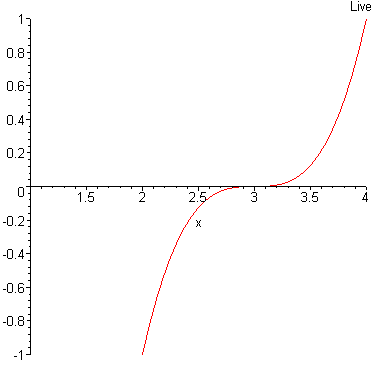We will consider only the real zeros of polynomials with real coefficients.
Location Theorem
If
are of opposite sign, then
between
Geometrically, this is obvious.
Remember that a continuous graph is drawn without lifting the pencil
off the sheet of paper. The graph is unbroken, is in one solid piece,
there are no breaks or jumps in the graph.
So if the graph has a point below the x-axis and another point above the
x-axis, the graph, in order to get from the first point to the second point,
must cross the x-axis somewhere between the two points.
In other words, it has an x-intercept between the two points.
(b, f(b))

(a, f(a))
See Figure 2, page 311.
This theorem can be used to locate the real zeros of a function.
See Example 1, page 312.
Any number that is larger than or equal to the largest zero of a polynomial
is called an upper bound of the zeros of the polynomial.
Any number that is less than or equal to the smallest zero of a polynomial
is called a lower bound of the zeros of the polynomial.
Using synthetic division, the following theorem
will enable us to determine a region within which all the real zeros
of a polynomial must be found.
Given an nth-degree polynomial
divided by
Upper Bound of Real Zeros
If
including the remainder, are nonnegative, then
real zeros of
Lower Bound of Real Zeros
If
including the remainder, alternate in sign, then
of the real zeros of
See Example 2, pages 313 - 314.
The above process locates where the real zeros are.
The following method is a way of actually approximating
the value of a real zero.
Again,
The Bisection Method
If
then a real zero
Bisect the interval. The midpoint is
Check the sign of
Choose the interval
has opposite signs at the endpoints.
Repeat this bisecting process until we get the number of decimal places
we want for the approximation of the zero. At any point in the process
if
See Example 3 - 6, pages 314 - 319.
top
next Rational Functions